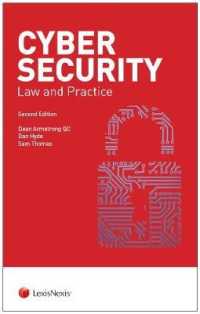- ホーム
- > 洋書
- > 英文書
- > Science / Mathematics
Full Description
All galaxies host a super-massive black hole in their center. These black holes grow their mass in symbiosis with their host galaxy and moderate their star formation. When matter is driven towards the nucleus, an accretion disk is formed to transfer angular momentum and considerable energy is released when the material falls into the black hole: this is the phenomenon of active galactic nuclei (AGN). A nucleus can shine one thousand times more brightly than the entire galaxy with its 200 billion stars. The nuclear activity can take many forms, from very powerful quasars to more ordinary Seyfert galaxies, passing by radio-galaxies, which eject a collimated plasma at ten times the radius of the galaxy.
This book examines all of these manifestations and presents a unified view. When two galaxies merge, a binary black hole is formed and the two black holes will spiral inwards and merge, emitting long gravitational waves, which could be detected by the future LISA satellite.
Contents
Chapter 1. Active Galactic Nuclei: Competition Between Accretion and Ejection 1
Suzy COLLIN-ZAHN
1.1. History: discovery and initial observations 1
1.2. Important observational properties 7
1.3. Interpretation I: thermal processes 19
1.4. Interpretation II: theoretical models 35
1.5. Towards a unified vision of AGNs 50
1.6. References 60
Chapter 2. The Galactic Black Hole 65
Mark MORRIS
2.1. Historical emergence of the Galactic black hole 65
2.2. The mass of the Galactic black hole 67
2.3. General relativity and the Galactic black hole 69
2.4. The accretion flow: radiative signatures of the Galactic black hole 72
2.5. Dynamics of the accretion flow 86
2.6. Outflows from the GBH 88
2.7. Perspectives 92
2.8. References 93
Chapter 3. AGN Accretion Disks 101
Jean-Pierre LASOTA
3.1. Introduction 101
3.2. Black holes 102
3.3. Disk driving mechanism; viscosity 107
3.4. Geometrically thin Keplerian disks 110
3.5. Disk instabilities 131
3.6. Beyond thin disks 139
3.7. Disk coronae 146
3.8. Disks, winds and jets 148
3.9. References 152
Chapter 4. Relativistic Jets and Very High Energy Mechanisms 155
Hélène SOL
4.1. The advent of ground-based gamma-ray astronomy 156
4.2. Very high energy gamma-ray observations of active galactic nuclei 159
4.3. Extragalactic jets, structures observed from sub-parsec to mega-parsec scales 168
4.4. Non-thermal emissions and instantaneous radiative models 177
4.5. Particle acceleration and time-dependent radiative models 194
4.6. Perspectives on active galactic nuclei at very high energies 211
4.7. References 221
Chapter 5. Galactic Bulge-Black Hole Co-evolution, Feeding and Feedback of AGNs 233
Françoise COMBES
5.1. Co-evolution: mass of black holes and bulges 233
5.2. Interpretations: cause or effect? 245
5.3. Black hole fueling processes 258
5.4. AGN feedback - efficiency 267
5.5. Conclusion 275
5.6. References 275
Chapter 6. Binary Black Holes in the Gravitational Wave Universe 281
Monica COLPI
6.1. Introduction 282
6.2. Black holes in the cosmic landscape 283
6.3. Gravitational waves from coalescing black hole binaries 287
6.4. The Gravitational Wave Universe 292
6.5. Black hole dynamics in merging galaxies 295
6.6. Multi-messenger view of a massive black hole merger 300
6.7. Concluding remarks 301
6.8. References 301
List of Authors 307
Index 309








